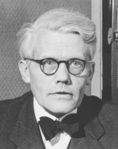Danish Folketing election, 1943
Danish Folketing election, 1943

|
|
|
|
All 149 seats to the Folketing
75 seats were needed for a majority |
| |
First party |
Second party |
Third party |
| |
 |
 |
|
| Leader |
Hans Hedtoft |
Christmas Møller |
Knud Kristensen |
| Party |
Social Democrats |
Conservative People's |
Venstre |
| Last election |
64 seats, 42.9% |
26 seats, 17.8% |
30 seats, 18.2% |
| Seats won |
66 |
31 |
28 |
| Seat change |
 2 2 |
 5 5 |
 2 2 |
| Popular vote |
894,632 |
421,523 |
376,850 |
| Percentage |
44.5% |
21.0% |
18.7% |
|
| |
Fourth party |
Fifth party |
Sixth party |
| |
|
|
 |
| Leader |
Jørgen Jørgensen |
Arne Sørensen |
Frits Clausen |
| Party |
Social Liberals |
Danish Unity |
National Socialists |
| Last election |
14 seats, 9.5% |
1 seat, 0.5% |
3 seats, 1.8% |
| Seats won |
13 |
3 |
3 |
| Seat change |
 1 1 |
 2 2 |
 0 0 |
| Popular vote |
175,179 |
43,367 |
43,309 |
| Percentage |
8.7% |
2.2% |
2.1% |
|
| |
Seventh party |
Eighth party |
| |
|
|
| Leader |
P. Gregersen |
Valdemar Thomsen |
| Party |
Justice |
Farmers' |
| Last election |
3 seats, 2.0% |
4 seats, 3.0% |
| Seats won |
2 |
2 |
| Seat change |
 1 1 |
 2 2 |
| Popular vote |
31,323 |
24,572 |
| Percentage |
1.6% |
1.2% |
|
|
|
Folketing elections were held in Denmark on 23 March 1943 alongside Landsting elections,[1] except in the Faroe Islands where they were held on 3 May. They were the first elections during the German occupation, and although many people feared how the Germans might react to the election, the event took place peacefully.[2] The voter turnout was at 89.5%, the highest of any Danish parliamentary election, and became a demonstration against the occupation. The Social Democratic Party remained the largest in the Folketing, with 66 of the 149 seats. After the elections, leading German newspapers expressed disappointment and indignation with the lack of political evolution among the Danish voters.[2]
The Communist Party of Denmark had been banned since 1941 and could not participate in these elections.
95% of the vote went to the four biggest, traditional democratic parties. In the years since, there has been some debate about whether this can be seen as democratic support for the government's "cooperation" policy (samarbejdspolitikken) with the German occupation authorities.[3] Some have argued that the result showed a broad unity of opinion in the population and among politicians in support of the relatively cooperative line taken by the government. Bertel Haarder, citing Knud Kristensen, has argued that the vote was sold as one of solidarity with the Danish constitution, democracy, and a rejection of totalitarian elements in society, and cannot therefore be seen as an explicit endorsement by the population of the government's line.[3]
Results
Denmark
| Party |
Votes |
% |
Seats |
+/– |
|---|
| Social Democratic Party | 894,632 | 44.5 | 66 | +2 |
| Conservative People's Party | 421,523 | 21.0 | 31 | +5 |
| Venstre | 376,850 | 18.7 | 28 | –2 |
| Danish Social Liberal Party | 175,179 | 8.7 | 13 | –1 |
| Danish Unity | 43,367 | 2.2 | 3 | +2 |
| National Socialist Workers' Party | 43,309 | 2.1 | 3 | 0 |
| Justice Party of Denmark | 31,323 | 1.6 | 2 | –1 |
| Farmers' Party | 24,572 | 1.2 | 2 | –2 |
| Independents | 28 | 0.0 | 0 | 0 |
| Invalid/blank votes | 29,800 | – | – | – |
| Total | 2,040,583 | 100 | 148 | 0 |
| Source: Nohlen & Stöver |
| Popular vote |
|---|
|
|
|
|
|
| A |
|
44.49% |
| C |
|
20.96% |
| D |
|
18.74% |
| B |
|
8.71% |
| R |
|
2.16% |
| N |
|
2.15% |
| E |
|
1.56% |
| F |
|
1.22% |
| Others |
|
0.00% |
Faroe Islands
The Faroes seat was won by Þ Petersen, an independent who was a member of the People's Party. However, his election victory was not recognised until 16 August 1945,[4] only two and a half months before the elections that year.
References
- ↑ Nohlen, D & Stöver, P (2010) Elections in Europe: A data handbook, p524 ISBN 978-3-8329-5609-7
- 1 2 Nordengaard, J. P. (1949). Valgene til Rigsdagen gennem 100 Aar (in Danish). Roskilde Dagbladstrykkeri. pp. chapter III, pp. 7–8.
- 1 2 Bertel, Haarder (21 September 2005). "Nye myter om samarbejdspolitikken" (in Danish). Information. Retrieved 14 February 2013.
- ↑ Nohlen & Stöver, p540

